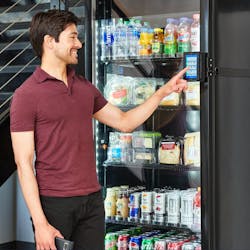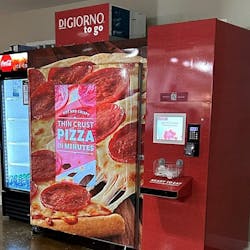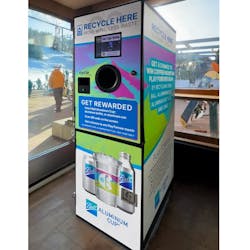For far too long, vending has been a single-sensory shopping experience. That is the sense of sight. Now we are seeing a multi-sensory experience develop. Sight — with moving images. Sound. There is the possibility of smell. At prior vending shows in London and Paris, we’ve seen machines dispensing perfumes and colognes — the opportunity to use aroma as a sales tool to attract and stimulate purchases. It is obvious — from the SPIO Media Network in the U.S. and video developments in Europe — that marketers are recognizing this opportunity.
At the recent D.A. Expo in Paris, France, there was fresh bread — not one, but two different machines. There were several new machines featuring the ability to deliver large packages — well beyond the traditional single-serve offering in U.S. vending machines. Let’s look at some of these highlights in more detail.
Daint from Catelgomberto, Italy, manufactures a vending machine that can display and deliver a wide range of products including single-serve and multiple servings — a much broader assortment of sizes than we are used to seeing in the U.S. The categories Daint is penetrating include food and beverages, health and beauty aids, books, wine and alcoholic beverages, and much more.
Products are displayed fully fronted and delivered to the shopper with an elevator. In a footprint not much bigger than a traditional vending machine, this is a “store front” opportunity. Here is an opportunity to broadly expand on what can be sold through a traditional vending machine.
If you recall the Horn & Hardart Automats in New York City and Philadelphia, Holland-based ADM Automaten manufactures a coin-operated unit which will bring you back to the old Automats. It can maintain hot or cold temperatures. The system is designed to be deployed at a staffed location. Each shelf must be restocked by hand after the product is sold. These units are successful for operators with limited staff at a location. Expected sell-through is to turn the full display once an hour.
In New York City you can go to a BAMN! Automat on St. Marks Place in Greenwich Village. This might be an opportunity for a location requiring both onsite or manual feeding and 24-hour vending service.
Adequat from Paris, France, distributes wall-mounted and standing vending machines. Wall-mounted machines represent an opportunity for vending operators to offer a broader selection of candy, mints and other small packages. These battery-operated machines will run 30,000 cycles — typically two-years of vending service.
MACHINES BAKE AND SERVE FRESH BREAD
If you been in Belgium, especially outside the major cities, you’ve probably seen vending machines standing in the open. These are bread machines selling loaves of fresh-daily bread. Verbeek manufactures a bread vending machine with capabilities to deliver more than bread. The machine’s elevator will deliver breads, packaged foods, non-foods and more. It can merchandise two items on the same shelf and deliver both in one cycle.
While I was familiar with bread vending machines, I was not ready for the two fresh-bread vending machines on the floor at the show.
According to Panicom in Hombourg-Haut, France, the threshold for profitability is 40 baguettes a day. The unit is called Panicho Automate. There is an oven to bake breads as needed. The machine is programmed to “learn” what the production levels should be, based on sales history. Under cold storage, there can be 120 to 250 baguettes. These can be held for up to 72 hours. From the process description, this would be par-baked (cold) breads ready to be baked.
There is the smell of fresh bread to attract and entice shoppers. There is a 15-second wait for the bread to be delivered — in a paper bag — just like you would get it from your local baker.
Pac Vending from Pessac, France has a machine that holds frozen bread that is baked and delivered hot in two minutes or less. The bread was great — just like buying a fresh baguette from a local bakery.
Jofemar’s new “green” hydrogen-powered vending machine was displayed. At the NAMA Show in St. Louis, Mo. they introduced this exciting model to the U.S. market. The power savings include power-reduction settings if the machine is not in use. This is an opportunity to place machines where there is no convenient power source.
Jofemar also presented a gourmet food machine. There is a built-in, double microwave oven to take cold/frozen foods to ready-to-serve. The other option is to use a microwave oven with grill capability.
ATEC from Aigrefeuille d’Aunis, France showed wood kiosks with layouts that can be open-sided or enclosed. The look is much more upscale than what you might expect from a vending kiosk. Think about the opportunity to dress up your vending sites.
Saeco has developed video display capabilities for their line of machines. The advertising opportunity alone is a great opportunity to drive sales and collect on media placements at locations.
Charal from Cholet, France is an integrated food manufacturer — from farm to the package. The Grillbox® package features top and bottom susceptors that allow the products to be grilled from both above and below. The company is relatively new in the vending channel. Entering vending was seen as an opportunity to expand brand presence and increase sales in a channel where the brand gets directly to the customer. The opportunity here is simple — deliver a better product using technology to offer shoppers something better than what is available now.
Roesler from Creteil, France manufactures what we might call a vending bin system. The units can be refrigerated. Among their target markets is the sale of farm-fresh eggs. This is a new opportunity for vending — selling to farmers and farmers’ markets.
PHONE CARD MACHINES OFFER DISPLAY PANELS
Libert-e from Montpelier, France had the most surprising thing at the show. Walking by an M&M vending machine, I stopped to notice that something was different. Instead of the usual full-front M&M display panel, there was an interactive screen, front and center. What was it selling? Telephone cards. There were separate payment accesses for the phone cards and for the vending machine. Many people in Europe buy phone cards for their mobile phones. Now vending operators can “rent” machine fronts to phone card sales companies.
Vending machines can be advertising venues. SPIO
Media Network is pursuing this opportunity in the U.S. Saeco is building in video capabilities to attract shoppers and drive sales of the brands being sold. Libert-e is “camping out” on vending machine fronts to sell telephone cards.
Soft drink bottles were displayed and dispensed upside down. I must admit that I didn’t have the nerve to open a soft drink that dispensed from an upside down position.
MERCHANDISING CAN CREATE NEW EXPERIENCES
New products can be “news” in vending machines. Displaying new items in a featured “new” slot will bring added attention to it. We know that new items “jump” out of the machine, generating trial purchase activity. Establishing a consistent placement point for new items is a good way to train customers to look for product news. Creating a “new” feature column — one that really stands out — should be an immediate priority.
Nutritional information is reaching package fronts in France. Pay attention to this issue. Don’t be surprised if new rules and regulations are enacted across the country. In New York City, chain restaurants must post the calorie count on their offerings. How would you react to such a requirement?
As much has changed, much remains the same. Food and beverages still must deliver on taste and flavor. Packages still must be attractive to get your attention. Vending machines must offer fast, easy payment options. Price/value relationships must appeal to shoppers. The Europeans seem to be ahead of us on that issue.
We are entering a new era for product merchandising. That applies to vending and all of the channels we compete with. The generation entering the workforce is different from the majority of the shoppers you serve today.
Don’t think that all of the answers will be based on what the vending channel is doing. You must look beyond vending to competing channels. For convenience stores, the classic description of c-store shoppers is changing, too. And you must look beyond the U.S. food industry, too.





